Space Machines
From space scooters to space ships, no mad scientist is complete without at least one plan for one of these..
Electric Propulsion
There are a few ways to do this from Ion to Cannae.. but how about an ellipse engine? If you want an electric-mechanical form of thrust that is easy. You need to build a variable speed, 2 stage asymmetrical ellipse engine. Think of it like a vibrator that only vibrates in one direction. You would need to spin two weights, in opposing directions to cancel out centrifugal rotation forces, on a “egg” shaped rotational trajectory.
Ie during the “return” phase of the spin, the weight should turn at a smaller radius, than the “thrust” phase. This alone would not be enough, - orbital physics would simply mean it would slow down on its “long” radius “thrust” phase thereby conserving energy - what you need to do here is the “variable” speed phase. During the “thrust” or start of the “long radius” stage of the rotation, you would need to speed up the rotational speed intentionally, to break conservation of energy by adding more energy to the system, then slow it down again for the “return” phase of the spin. This would result in an asymmetrical application of directional centrifugal force - thereby propelling the vehicle.
It cant be that simple you may say. In some ways you would be correct, the speed control of the electric motor spinning the weight would need to be very precise - but not that precise. For a simple real world application of this effect consider the following two scenarios which are this principle applied in the real world.
1: Consider the “hammer toss” at the olympics. A hammer is spun over the athletes head then he extends his arm and forces energy into the spin, changing it to an ellipse, then releasing the hammer at the apex of the ellipse. If at this stage he forgot to release the hammer, he would be forced forward several steps by the release of directional forces. If he kept spinning and forgetting to let go, he would soon find himself standing at the other end of the sports field.
2: Consider the humble playground “swing” a child throws their legs out during the forward stage, and pulls their leg in during the return phase, resulting in a simple resonant build of forward momentum, thereby sustaining ever increasing “swing” sweeps.
